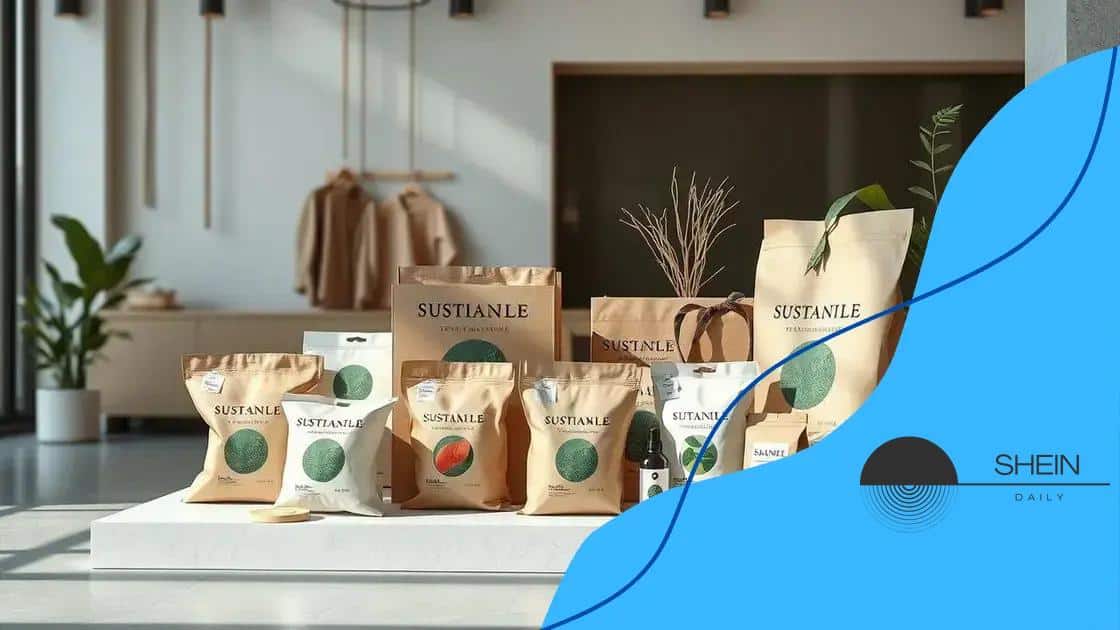Shein’s innovation in packaging and waste reduction

Shein’s innovation in packaging and waste reduction focuses on using eco-friendly materials and sustainable practices to meet growing consumer demand for responsible fashion.
Shein’s innovation in packaging and waste reduction is transforming the fashion landscape. As consumers become more environmentally conscious, brands like Shein are making strides to adapt. But how exactly are they reshaping their practices?
Understanding Shein’s sustainable packaging initiatives
Understanding Shein’s sustainable packaging initiatives is essential for grasping how the fashion industry is evolving. Shein, a leading fast-fashion retailer, has recognized the importance of environmental responsibility and is taking steps to improve its packaging methods.
One of the most notable initiatives is the shift towards eco-friendly materials. Instead of traditional plastic, Shein is exploring biodegradable options that minimize environmental impact. This transition is not only beneficial for the planet but also appeals to consumers who prioritize sustainability in their purchasing decisions.
Innovations in Packaging
Shein’s packaging innovations include:
- Recyclable Materials: Many of their shipping materials are now made from recyclable substances.
- Minimalist Design: Reducing excess materials to create a more compact and efficient package.
- Reusable Packaging: Some initiatives encourage consumers to reuse packaging for returns, further reducing waste.
These innovations reflect a growing trend within the industry to adopt more sustainable practices. Shein’s commitment to reducing waste is not just a marketing strategy; it is a necessary step towards a more responsible fashion industry.
Additionally, the company is also looking at reducing the carbon footprint associated with shipping and packaging. By optimizing their logistics, they can minimize the transportation emissions linked to their products. This holistic approach aligns with global efforts to combat climate change and appeals to a broader audience.
As consumers become increasingly aware of environmental issues, brands like Shein must continue to innovate. The shift towards sustainable packaging is a crucial part of their strategy, ensuring they remain relevant and responsible in today’s market.
The impact of waste reduction in fashion
The impact of waste reduction in fashion is becoming increasingly significant as the industry seeks to address environmental challenges. Reducing waste helps not only the planet but also consumers and brands.
One major aspect of waste reduction is the process of upcycling. Brands incorporate leftover materials into new products, minimizing waste that would typically end up in landfills. This innovative approach allows companies to create unique items while staying mindful of their ecological footprint.
Benefits of Waste Reduction
There are several key benefits to reducing waste in the fashion industry:
- Environmental Protection: Lower waste means less pollution and harm to ecosystems.
- Resource Conservation: Using existing resources helps conserve water and energy.
- Cost Efficiency: Reducing waste can lead to decreased production costs for brands.
- Consumer Appeal: Shoppers increasingly prefer brands with sustainable practices.
Fashion brands are now rethinking their production techniques to embrace the circular economy. This concept encourages manufacturers to design products with their end-of-life in mind. By creating clothing that can be easily recycled or decomposed, brands can significantly reduce their overall waste.
Additionally, consumer awareness plays a key role in the shift toward waste reduction. Shoppers are more informed than ever about the impacts of their choices. Many are willing to support brands that demonstrate a commitment to sustainability. This trend encourages other companies to adopt similar practices, creating a ripple effect throughout the industry.
Consumer reactions to Shein’s eco-friendly changes

Consumer reactions to Shein’s eco-friendly changes have varied as awareness of sustainability grows. Many consumers are actively seeking brands that prioritize the environment.
As Shein implements eco-friendly initiatives, customer feedback highlights both excitement and skepticism. Some shoppers appreciate the company’s efforts, praising the use of recyclable materials. This move resonates with environmentally conscious buyers who want to support sustainable fashion.
Positive Feedback
Many consumers express support for Shein’s changes. Key reactions include:
- Appreciation for Transparency: Customers value honesty about manufacturing practices.
- Positive Brand Image: Sustainable initiatives enhance Shein’s reputation in the market.
- Product Variety: Eco-friendly items attract new customers looking for stylish options.
However, there are also voices of caution. Some customers wonder if these changes are genuine or if they are simply a marketing tactic. They question the speed at which Shein is implementing these sustainable practices. Many shoppers prefer to see consistent efforts over time.
Challenges Ahead
As Shein navigates consumer reactions, challenges remain. Critics point out that the fashion industry still generates vast amounts of waste. Customers want assurance that the brand’s commitment is more than just a trend. For Shein to succeed, ongoing communication with consumers is essential.
Engagement with customers through surveys and social media can help address concerns. By actively involving shoppers in discussions about sustainability, Shein can build trust and loyalty. Consumers appreciate the opportunity to provide feedback on sustainable practices and product offerings.
Comparing Shein’s practices with industry standards
Comparing Shein’s practices with industry standards sheds light on how the brand aligns with or diverges from commonly accepted practices in sustainable fashion.
Many fashion companies are increasingly focusing on sustainability. Shein is under scrutiny as it implements eco-friendly initiatives. While some brands utilize transparent supply chains, Shein is still improving in this area. However, it has begun taking steps toward responsible sourcing.
Industry Standards
Common sustainability practices in the fashion industry include:
- Ethical Sourcing: Brands should ensure their materials are sourced responsibly and not harmful to the environment.
- Transparency: Many companies provide clear information about their production processes.
- Waste Management: Effective practices include recycling and upcycling materials.
- Carbon Reduction: Strategies aim to lower emissions in production and transportation.
In comparison, Shein’s journey towards sustainability is noteworthy. The company has started to reduce plastic use in packaging, a major point for improvement. This move aligns with the industry’s push towards minimizing environmental impact.
Shein is also exploring partnerships with organizations dedicated to promoting sustainable practices. These collaborations can help the brand learn about eco-friendly methods and improve its practices further. Some critics argue that Shein must offer more substantial commitments to match leaders in sustainability.
Areas for Improvement
Despite some progress, Shein faces challenges compared to more established sustainable brands. Key areas that need attention include:
- Greater Transparency: More open communication about sourcing and production is necessary.
- Long-term Goals: Setting and communicating clear sustainability targets can enhance credibility.
- Engagement with Consumers: Involving customers in sustainability efforts can build trust.
Through these comparisons, it becomes evident that while Shein is making strides, further improvements can help position the brand as a leader in sustainable fashion.
Future prospects for sustainable fashion brands
Future prospects for sustainable fashion brands look bright as consumer awareness of environmental issues continues to grow. More people are choosing to support brands that prioritize sustainability.
As the demand for eco-friendly products rises, sustainable brands are expected to expand their influence. These brands are focusing on innovative practices, such as using recycled materials, and reducing their carbon footprint. The industry’s shift towards sustainability is not just a trend; it’s a necessary response to climate change.
Emerging Trends
Several key trends are shaping the future of sustainable fashion:
- Technology Integration: Advancements in technology will enhance the production process, making it easier to create sustainable products.
- Circular Fashion: The concept of circularity focuses on recycling and repurposing items, reducing waste.
- Consumer Participation: Shoppers are increasingly involved in sustainability efforts, demanding more transparency and ethical practices from brands.
- Collaboration: Brands partnering with environmental organizations to enhance their sustainability initiatives.
As these trends develop, sustainable fashion brands that adapt will succeed. Staying ahead of consumer preferences is key. Brands must also ensure that their practices reflect genuine commitment rather than mere marketing strategies.
Challenges Ahead
Despite the positive outlook, challenges remain. Competition is fierce in the fashion industry, and sustainable brands often face higher production costs. Consumers may be hesitant to pay more for eco-friendly items. Addressing these concerns is crucial for growth.
Moreover, sustainable brands need to navigate the complexities of supply chains. Sourcing materials responsibly and maintaining ethical practices can be challenging. Building strong relationships with suppliers and investing in sustainable technologies can mitigate these issues.
Overall, the future of sustainable fashion brands hinges on innovation, consumer engagement, and a steadfast commitment to genuine sustainability.
Conclusion:
In summary, Shein’s innovation in packaging and waste reduction reflects a significant shift in the fashion industry towards sustainability. As environmental awareness grows, brands must adapt to consumer preferences for eco-friendly practices. Shein’s efforts showcase both challenges and opportunities, emphasizing the importance of genuine commitment to sustainable practices. The future of sustainable fashion looks promising, with emerging trends and consumer engagement playing vital roles in shaping the industry.
FAQ – Frequently Asked Questions about Shein’s Sustainable Practices
What initiatives is Shein implementing for sustainability?
Shein is focusing on using recyclable materials in packaging and exploring eco-friendly production practices to reduce waste.
How do consumer preferences affect Shein’s sustainability efforts?
As consumers become more environmentally conscious, they increasingly demand sustainable options, pushing Shein to adapt its practices.
What challenges does Shein face in becoming a sustainable brand?
Shein faces challenges like higher production costs for sustainable materials and competition from other brands committed to sustainability.
Why is transparency important for Shein’s reputation?
Transparency in sourcing and production helps build consumer trust and reinforces Shein’s commitment to genuine sustainable practices.





